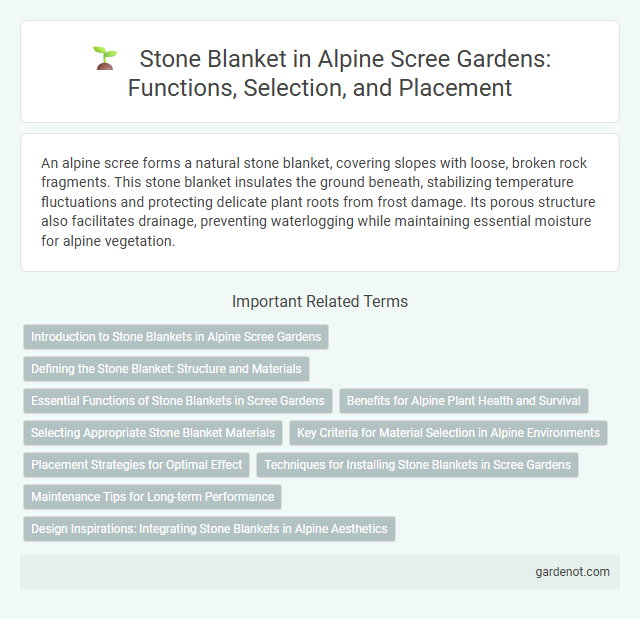An alpine scree forms a natural stone blanket, covering slopes with loose, broken rock fragments. This stone blanket insulates the ground beneath, stabilizing temperature fluctuations and protecting delicate plant roots from frost damage. Its porous structure also facilitates drainage, preventing waterlogging while maintaining essential moisture for alpine vegetation.
Introduction to Stone Blankets in Alpine Scree Gardens
Stone blankets in Alpine scree gardens serve as natural ground cover composed of carefully arranged small to medium-sized rocks that mimic the habitat of high-altitude mountainous regions. These stone layers enhance drainage, reduce soil erosion, and create microclimates ideal for alpine plants to thrive in harsh conditions. Implementing stone blankets supports biodiversity by providing shelter and moisture retention, essential for the survival of delicate scree flora.
Defining the Stone Blanket: Structure and Materials
The stone blanket in alpine scree consists of a dense layer of angular rock fragments that cover the soil, creating a protective shield against erosion and frost. This structure is primarily composed of gravel, cobbles, and boulders derived from weathered bedrock, varying in size and mineral composition depending on the local geology. The permeability and stability of the stone blanket influence soil moisture retention and insulation, crucial for alpine plant survival and geomorphological processes.
Essential Functions of Stone Blankets in Scree Gardens
Stone blankets in alpine scree gardens stabilize soil erosion by creating a protective layer that reduces surface runoff and sediment displacement. They enhance moisture retention, promoting root growth and supporting native plant establishment in harsh mountainous environments. Serving as thermal insulators, stone blankets moderate soil temperature fluctuations, crucial for sustaining diverse alpine flora.
Benefits for Alpine Plant Health and Survival
Stone blankets in alpine scree create favorable microhabitats by regulating soil temperature and moisture levels, which enhances alpine plant health and survival. These rocky covers protect delicate root systems from frost damage and reduce water evaporation, ensuring consistent hydration. The shelter provided by stone blankets also minimizes soil erosion, promoting stable growth conditions for alpine vegetation.
Selecting Appropriate Stone Blanket Materials
Selecting appropriate stone blanket materials for Alpine scree involves choosing angular, durable stones with high resistance to weathering and frost. Optimal stone size ranges between 30 and 100 millimeters to ensure effective drainage and stability while preventing soil erosion. Using locally sourced materials reduces environmental impact and maintains ecological balance in fragile mountain ecosystems.
Key Criteria for Material Selection in Alpine Environments
Stone blankets must prioritize durability and resistance to freeze-thaw cycles in alpine environments, ensuring long-term stability against harsh weather conditions. Material selection focuses on angular, coarse-grained rocks that provide excellent drainage while preventing soil erosion on steep scree slopes. Lightweight yet robust stones minimize installation challenges at high altitudes where accessibility is limited.
Placement Strategies for Optimal Effect
Stone blanket placement strategies in alpine scree focus on maximizing soil stabilization and moisture retention by carefully arranging rock fragments according to slope angle and substrate composition. Optimizing particle size distribution and layering techniques enhances interlocking and reduces erosion caused by freeze-thaw cycles and surface runoff. Strategic positioning of larger stones on top improves protection against environmental stressors, promoting vegetation establishment and long-term ecosystem resilience.
Techniques for Installing Stone Blankets in Scree Gardens
Stone blankets install by first preparing a stable, sloped surface on alpine scree to prevent erosion and promote drainage. Anchoring techniques involve overlapping geotextile fabrics beneath carefully layered stones to secure the blanket against gravity and wind displacement. Strategic stone placement utilizes larger rock fragments at the base for stability, with smaller stones above to create a natural, cohesive scree garden structure.
Maintenance Tips for Long-term Performance
Regularly inspect the stone blanket for displacement caused by wind or water erosion to maintain its protective function on the alpine scree. Replenish and reposition loose stones to ensure consistent coverage that minimizes soil erosion and promotes vegetation stability. Implement seasonal clean-ups to remove debris and prevent moss or algae growth, preserving the stone blanket's permeability and durability over time.
Design Inspirations: Integrating Stone Blankets in Alpine Aesthetics
Stone blankets mimic the natural layering of alpine scree, providing erosion control while blending seamlessly with rugged mountain landscapes. Their design draws inspiration from the irregular distribution and varied sizes of alpine stones, enhancing both functionality and visual harmony. Incorporating stone blankets in alpine aesthetics ensures stability and reinforces the environment's raw, textured appearance.
Stone blanket Infographic

 gardenot.com
gardenot.com